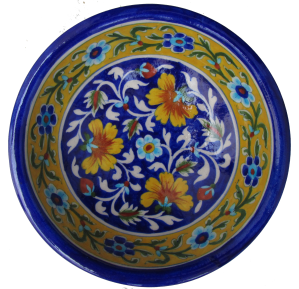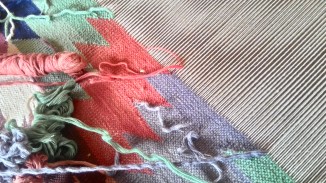Moving a little away from the blue city, Jodhpur, with its ever mighty and vigilant Mehrangarh fort, one enters the realms of nature loving communities that inhabit them. Peacocks resting in the shade of the thorny trees, nilgais trying to reach the tallest of branches for food and even herds of antelopes grazing in the afternoon sun, makes it a wonderful experience. The locals, here, believe in staying in harmony with nature for which they even feed quintals of food grains to their regular guests, the Demoiselle cranes, who fly thousands of miles all the way from Eurasia to flock in hundreds every year. Within this wilderness, it is the home of the famous panja dhurries, a name acquired because of the claw shaped tool used for making these rugs. Initially, the weavers created these rugs out of coarse animal hair, either goat or camel. Therefore, these rugs were almost monochromatic, with only the natural breed colour of the animal. Also, known as jhatpatti[i] rugs, literally meaning made in haste, they were used only for domestic purpose. Today with wider options and not ignoring market demands, they are also woven with dyed cotton yarns depicting various complex geometric patterns with playful colours.
[i] Aditi Ranjan and M.P. Ranjan, eds. Crafts of India: Handmade in India. (New Delhi: Council of Handicraft Development Corporations, COHANDS, 2007), 112.
Other interesting reads on Dhurries:
Chaldecott, Nada. Dhurries: History, Pattern, Technique and Identification. London: Thames and Hudson Ltd., 2003.
Chattopadhayay, Kamaladevi. Indian Carpets and Floor Coverings. New Delhi: All India Handicrafts Board, Date of publication not mentioned.
Cohen, Steven. The Unappreciated Dhurrie: A Study of the Traditional Flatwoven Carpets of India. Edited by David Black and Clive Loveless. London: David Black Oriental Carpets, 1982.








Good sushmit…….
LikeLiked by 1 person
Thank you Ravi !!!
LikeLike